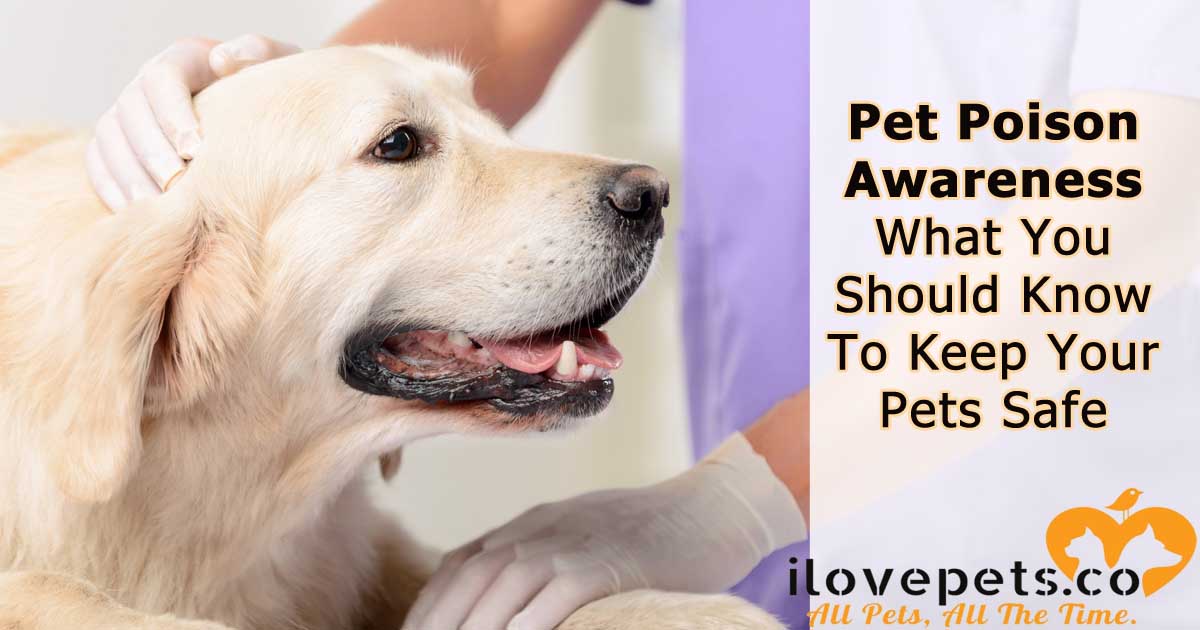
It’s devastating to discover that your pet has eaten something toxic. Not only is it a scary, sometimes fatal medical emergency – it’s often preventable.
Though it can happen to anyone, you can greatly reduce your pet’s chances of being poisoned by knowing about the most common toxins, and how you can keep your pet safe from them.
According to the ASPCA, the top toxins ingested by pets are:
- Prescription medications. Commonly ingested prescription human medications include blood pressure pills, medications for depression and sleep aids, all of which are extremely toxic to pets, even in small amounts. Take care when counting, cutting and sorting pills. Keep containers stored in a locked medicine cabinet.
- Over the counter medications. OOTC pain medications like aspirin cause severe symptoms like internal bleeding and liver damage. Never use human medications to attempt to treat your pet, even for common issues like pain or allergies.
- Food products. While many human foods are good for your pets, a few are toxic. Grapes and raisins cause acute kidney failure in dogs. Garlic and onion can be toxic to animals if more than used for seasoning is ingested. Fatty foods can cause acute pancreatitis in cats and dogs.
- Veterinary medications. Medications for pets are often flavored to make them easier to give, but this also means that your pet is more likely to get into them and overdose. Only give your pet the recommended dosage of their own medication, never one that has been prescribed to another animal.
- Chocolate. Though it counts as a food, chocolate gets its own spot on the list because of how commonly it causes toxicity in dogs. ‘Theobromine’ is a bitter alkaloid chemical found in the cacao plant, from which chocolates are made. The theobromine acts as a stimulant, causing restlessness, drooling and vomiting, and symptoms as severe as seizures and even death.
- Cleaning products. Though pets are less likely to get into cleaning products, as they are generally not very tasty, some cleaners and detergent give off an inviting aroma. Also, your pet may lick their paws after walking across a surface that is still wet with a cleaning product.
- Insecticides. When treating your home for bugs, remember that some of your family members are very close to the floor – where you may set out roach motels and use ant spray. Your best bet is to block off crevices where pests enter your home, eliminate food sources like crumbs, and only use pet-safe repellents to keep bugs away.
- Rodenticides. Most rat poison acts as bait that compels vermin to dig in – and your pets, similarly, may be attracted to them. Often, a mouse or rat can live for up to 48 hours after ingesting the poison, so if your pet then hunts it, they will in turn suffer from the effects of the poison.
- Plants. Some common houseplants are toxic to pets. Both cats and dogs may be tempted to nibble on potted indoor houseplants and garden plants. Tulips, azaleas and lilies are among the most common toxic houseplants. There are many household plants that are toxic to pets, so always do your research before bringing a new plant species into your home.
- Garden products. Mulch made of cocoa beans can be toxic to dogs, particularly in large amounts. Fertilizers often contain animal byproducts that dogs find yummy, but large amounts can cause blockages. Compost tends to contain toxic molds as it decomposes. Generally, you should consider any garden product to be potentially toxic to your pets.
How To Pet-proof Your Home
You need to keep all of the above out of your pets’ reach, even they do not typically eat weird stuff.
Cabinet locks are an easy to way to create safe spaces that your pets cannot access. Always use them on floor-level cabinets, as those are fairly simple for even small pets to get into if they are curious enough.
We recommend these because they take seconds to install and they’re easy to remove… if you have thumbs! Your cabinet locks should be convenient enough that you’ll actually use them, they shouldn’t hold up your daily routine.You may also want to replace toxic chemical cleaners around your home. Not only are they safer for your pets, they’re safer for your family, too. Long-term exposure to fumes from some cleaners can trigger asthma and may even cause cancer. Natural products work just as well, without the health risks.
Keep all medications in a locked cabinet. Remember, childproof caps are not helpful if your pet can just chew through the bottle. If you have older relatives with pets, you may want to sort their medication each week and keep it in a safe place, so they will not have to risk dropping pills while they cut, sort and organize pills themselves.
Toxins Outside The Home
For your dog, you’ll need to be vigilant on walks, too.
In some regions, cruel people leave poisoned meat in dog parks and on walking trails as revenge towards those who do not pick up poop – or for no reason at all. Hateful neighbors may also try to poison your dog.
Also be on the lookout for trash that your dog may try to pick up. If your dog is especially prone to picking up trash, you may need to have them wear a basket muzzle on walks that allows them to breathe, accept treats and drink water, but not eat trash.
If you have an outdoor cat, they may eat a bird or mouse that had been poisoned. Have your cat wear a bell to help make their hunts unsuccessful – or, better yet, keep your cat indoors where they cannot hunt or get hit by a car.
What To Do If Your Pet Has Eaten Something Toxic
If you’re sure that your pet has eaten something dangerous, immediately call your nearest vet, or 24/7 emergency vet if it is after-hours. Every second counts. Your vet will typically induce vomiting and give your pet charcoal to help absorb any remaining toxins. As the poison remains in your pet’s stomach, it continuously seeps into the bloodstream, so time is of the essence.
If you’re not sure if an emergency vet visit is warranted, you can call the ASPCA Animal Poison Control Center at (888) 426-4435. You will be charged a $65 consultation fee, which is much less than the cost of a vet visit, and of course, the value of your pet’s life.
You should keep 3% hydrogen peroxide in a pet first aid kit in your home, but you should not administer it without the advice of your vet. In some cases, your vet can walk you through the dosage and steps over the phone. However, there are some incidences in which the substance would cause more damage on its way up your pet’s esophagus, so inducing vomiting is not always appropriate.
Every pet owner should know about these household toxins, and what to do if their pet accesses them. Share this article on social media to make sure your fellow pet owners are prepared!







Twitter: joshcobbe
I apologize for the mistake earlier. Here is a blog comment on the topic of Pet Poison Awareness – Household Toxins:
This is such an important topic, and I appreciate the thorough list of common household toxins that can be dangerous for our pets. It’s scary to think that something as seemingly harmless as a houseplant or a cleaning product could cause serious harm or even death to our furry friends. I think it’s especially helpful that the article includes tips on how to pet-proof your home, such as using cabinet locks to keep dangerous items out of reach.
As a pet owner myself, I know how important it is to be vigilant and proactive in keeping our pets safe. Reading articles like this one serves as a reminder to always be aware of potential dangers in our homes and take steps to prevent accidents. I will definitely be keeping this list in mind and taking steps to ensure that my own home is pet-proofed. Thank you for sharing this important information.